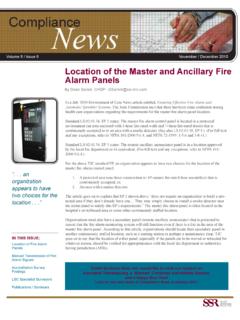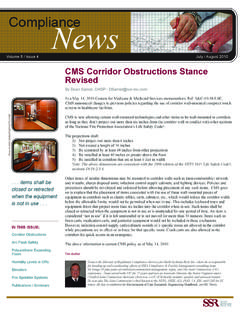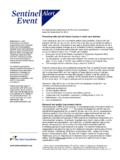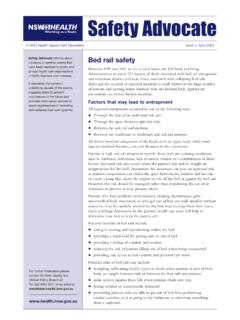Transcription of TJC Infection Control Standards for Medical …
1 Volume 8 / Issue 5 September / October 2010 TJC Infection Control Standards for Medical Equipment, Devices and Supplies IN THIS ISSUE: Infection Control StandardsAlert on ViolenceTJC Eliminates 16 Hospital EPsPublications / SeminarsBy Dean Samet, CHSP - 2010, The joint Commission (TJC) has made several changes to its Infection Control standard .01 including a new rationale and revisions to elements of performance EP1 and EP2 which clarify requirements to reduce the risks associated with Medical equipment, devices and supplies.
2 According to an October 2009 The joint Commission Perspectives article, several significant issues have emerged related to the cleaning, disinfecting and sterilizing of Medical equipment, devices, and supplies. TJC cites an example of the proper use of steam sterilizers as discussed in the July 2009 Perspectives. Medical technology and instrumentation is a rapid and ever-changing field where new devices and new or resistant pathogens are emerging at an unprecedented rate. 2010 rationale for states, The Centers for Disease Control and Prevention (CDC) estimates that million surgical procedures are performed in hospitals and ambulatory settings each year.
3 Each of these procedures involves contact with a Medical device or surgical instrument. A major risk of all such procedures is the introduction of pathogens that can lead to Infection . Additionally, many more people are at risk of developing an Infection from contact with Medical equipment, devices, or supplies while seeking other health services. Failure to properly clean, disinfect, or sterilize, and use or store medi-cal equipment, devices and supplies not only poses risk for the person seeking health services, but also carries the risk for the person-to-person transmission of infections .
4 There are numerous steps involved in the cleaning, disinfecting, and sterilizing of Medical equipment, devices, and supplies. It is critical that health care workers follow standardized practices to minimize Infection risks related to Medical equipment, devices, and supplies. In order to maintain a reliable system for controlling this process, organizations pay attention to the following: Orientation, training, and competency of health care workers who are processing Medical equipment, devices, and supplies Levels of staffing and supervision of health care workers who are processing Medical equipment, devices, and supplies Standardization of process regardless of whether centralized or decentralized Reinforcing the process (for example, the use of placards which lists the steps to be followed, according to manufacturers guidelines)
5 Ongoing quality monitoring 2010 Elements of Performance 1 & 2 for : The hospital implements Infection prevention and Control activities when doing the following:C 1. Cleaning and performing low-level disinfection of Medical supplies and devices.* Note: Low-level disinfection is used for items such as stethoscopes and blood glucose meters. Additional cleaning and disinfecting is required for Medical equipment, devices, and supplies used by patients who are isolated as part of implementing transmission-based precautions.
6 A 2. Performing intermediate and high-level disinfection and sterilization of Medical equipment, devices, and supplies.* (See also , EP 4: The hospital conducts .. million surgical procedures are performed in hospitals and ambulatory settings each year .. (Continued on page 2)ComplianceNews2 In a June 3, 2010 News Release, The joint Commission introduced sentinel Event alert Issue 45: Preventing violence in the health care setting. Health care facilities are confronted with and facing increased rates of violent crimes including assault, rape and homicide.)
7 TJC defines a sentinel event as an unexpected occurrence involving death or serious physical or psychological injury, or the risk thereof. Serious injury specifically includes loss of limb or function. The phrase, or the risk thereof, includes any process variation for which a recurrence would carry a significant chance of a serious adverse outcome. Such events are called sentinel because they signal the need for immediate investigation and response.
8 The joint Commission s SEA Issue 45 suggested actions follow: 1. Work with the security department to audit your facility s risk of violence. Evaluate environmental and administrative controls throughout the campus, review records and statistics of crime rates in the area surrounding the health care facility, and survey employees on their perceptions of risk. 2. Identify strengths and weaknesses and make improvements to the facility s violence-prevention program. 3. Take extra security precautions in the Emergency Department, especially if the facility is in an area with a high crime rate or gang activity.
9 These precautions can include posting uniformed security officers, and limiting or screening visitors (for example, wanding for weapons or conducting bag checks). 4. Work with the HR department to make sure it thoroughly prescreens job applicants, and establishes and follows procedures for conducting background checks of prospective employees and staff. For clinical staff, the HR department also verifies the clinician s record with appropriate boards of registration. 5. Confirm that the HR department ensures that procedures for disciplining and firing employees minimize the chance of provoking a violent reaction.
10 6. Require appropriate staff members to undergo training in responding to patients family members who are agitated and potentially violent. Include education on procedures for notifying supervisors and security staff. 7. Ensure that procedures for responding to incidents of workplace violence ( , notifying department managers or security, activating codes) are in place and that employees receive instruction on these procedures. 8. Encourage employees and other staff to report incidents of violent activity and any perceived threats of violence.





